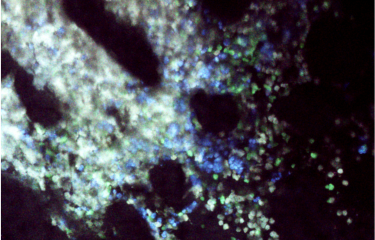Symptoms and treatment
ATLL
Adult T-cell leukemia/lymphoma (ATLL), in its acute or lymphomatous form, is a highly aggressive, rapidly developing type of cancer that is resistant to chemotherapy. Patients generally die within a year. It occurs in individuals aged between 20 and 70, most often those in their 50s. Symptoms vary and are often complicated by skin lesions and enlarged lymph nodes, liver or spleen. The leukemia or lymphoma cells infiltrate various organs. In addition to the acute forms of the disease, there are some forms in which patients have few abnormal T cells in their bloodstream and show no severe signs of the disease for a long period. Some people also suffer from chronic forms in which the level of leukemia cells is high but the disease can remain stable for a certain length of time.
Currently, the only existing therapy is bone marrow transplantation. This can lead to a cure, but it is not possible in all cases, and it can be difficult to find a compatible donor.
Various trials combining chemotherapy and/or antiviral drugs are beginning to yield encouraging results, especially for the chronic forms, but the prognosis for the acute and lymphomatous forms remains poor.
HTLV-1 associated myelopathy/tropical spastic paraparesis (HAM/TSP)
HAM/TSP is a disease that occurs in adults, mostly women, around the age of 40-50. It generally starts insidiously, often with lumbago and urinary problems. Although the rate of progression varies, after 10 years nearly 50% of patients are bedridden. In the chronic phase, the clinical profile is dominated by paraparesis or spastic paraplegia. Sensory impairment is generally moderate and the patient's general condition is unchanged at the onset of the disease. Sphincter dysfunction is frequent. The peripheral nervous system is rarely affected, and associated myositis is also rare. Systemic symptoms may sometimes occur, including lymphocytic alveolitis, uveitis and arthritis.
Epidemiology
Two diseases associated with the virus
HTLV-1 was initially associated with adult T-cell leukemia/lymphoma (ATLL), hence the name (human T-cell leukemia/lymphoma virus). ATLL is a type of leukemia or lymphoma that is frequent in south-west Japan, where around 700 new cases are diagnosed each year out of around a million carriers of HTLV-1.
The link between HTLV-1 and a myeloneuropathy known as "tropical spastic paraparesis" was then established in the West Indies. We now know that this disease is frequent in all areas that are highly endemic for HTLV-1, especially the French West Indies and French Guiana.
The cumulative risk of developing either of these diseases after HTLV-1 infection is around 5%.
But HTLV-1 also gives rise to other syndromes that remain under-researched, including infective dermatitis, uveitis and myositis. When these conditions are added to the equation, the risk of developing a disease after HTLV-1 infection in one’s lifetime reaches nearly 10% in some regions.
The origin of this virus in humans is most probably linked with inter-species transmission of a closely related retrovirus known as STLV-1, which is endemic in several Old World monkey species, especially in Africa.
HTLV-2, a virus related to HTLV-1
HTLV-2, a virus related to HTLV-1, mainly affects intravenous drug users in the United States and Europe, but it is also endemic in several indigenous American populations and some Pygmy populations. We know little about the diseases associated with this virus, which seem to be very rare.
Transmission
In endemic countries, there is a high risk of mother-to-child transmission: around 15 to 20% of children of infected mothers are infected in turn, mostly during extended breastfeeding. HTLV-1 may also be sexually transmitted, mainly from men to women. The prevalence of infection is higher in women than in men. In highly endemic areas, seroprevalence increases with age. Transmission by blood transfusion can now be avoided by screening blood donations – screening is carried out in many countries including Japan, the United States and France (since July 1991).
Other diseases caused by the virus
Other syndromes associated with HTLV-1 include a certain degree of immunosuppression, uveitis in young adults – especially in Japan –, infective dermatitis in children – mainly in Jamaica and Brazil –, and myositis and polymyositis.
Unfortunately there is currently no available vaccine.
July 2021





